Xiamen SightseeingVisit Xiamen's Landmarks and Immerse in Chinese Culture
The main pleasure in Xiamen, apart from Gulangyu Island, is simply walking the streets of the old city. Starting from the Siming and Zhongshan Road intersection, there is a pleasant mix of early twentieth-century and clean orderly streets, pavements and shops. At the western end of Zhongshan Lu, people can view the island of Gulangyu right in front across the water.
Southeast and east from the town center there's a thin scattering of tourist sights. On Siming Nan Lu, about 2 kilometers south of Zhongshan Lu, located the Oversea Chinese Museum. This houses collections presented by the huge Fujianese dispersed around the world, including pottery and some exceptional bronzes going back as far as the Shang Dynasty, three thousand years ago. On the ground floor is a display of paintings, photographs and relics depicting the life of Chinese people abroad over the centuries.
Jimei was the hometown of the distinguished overseas Chinese leader Chen Jiageng and is one of the four major science attractions in Xiamen. Viewed from above, this place is extremely beautiful. The academic atmosphere and attractive natural scenery of Jimei is manifested by attractions such as Jimei Study Village and Ao Yuan. In addition, Guilai Tang, Jiageng Park, etc. are also worth visiting.
Jimei not only collects the beauty of nature, of architecture but also reveals the love of overseas Chinese for their motherland. From 1912 on, Chen Jiageng lived here for about fifty years and financed a large scale construction of the teachers' school, navigation school, commerce school, farming machine school, kindergartens, primary schools and middle schools, thus bringing about a title of academic village to the place. Before his death, Chen built Ao Park, which is decorated with several hundred granite reliefs of animals, people and landscape. On the forty odd stone columns are carved figures of national leaders and inscriptions by celebrities, thus making it a modern collection of inscriptions. After Chen's death, Ao Park serves as his mausoleum. In Homecoming Park stands Mr. Chen Jiageng's bronze statue, behind which is the inscription "A banner of overseas Chinese and elitist of the nation" written by Mao Zedong, expressing his high opinion of Chen.
Wanshishan tourist area located on the north piedmont of Mt. Shishan in the east of Xiamen boasts a unique sight of exotic rocks and stones as well as various subtropical plants. Tong'an tourist area also has many interesting attractions to see.
During the Ming Dynasty (1368-1644), the island was called 'Yuanshazhou Island'. It got its present name from the huge reef surrounding it. When the tide comes in, the waves pound the reef and it sounds like the beating of a drum. The island came to be named 'Gulang'. Gu in Chinese means 'drum', and Lang, 'waves'. Enjoying a laudatory title of the "Garden on the Sea" with an area of 1.78 square meters, Gulangu Island is separated from the downtown of Xiamen by a 500 meters wide strait. Its name, meaning "drumming wave" came from the rocks in the southwest that gives a drumming sound when high tide hits them. Gulangyu Island is renowned for its delicate natural beauty, its ancient relics, and its varied architecture. The island is on China's list of National Scenic Spots and also ranks at the top of the list of the ten most-scenic areas in Fujian Province. On the undulate hills, villas of western styles are embedded in the green trees, red flowers, blue waves and white clouds, thus, the islet is praised to be a "Museum of International Architecture." The courtyards and small lanes among flowers and trailers are completely free from noise of vehicles and filled with fragrance and melodious music, giving one sense of fairyland. Gulangyu's narrow tangle of streets can be a confusing place to find your way around, but the compactness of the island (it's less than two square kilometers in size) means this isn't really a problem. The various sights are scattered around the island and any stroll through the streets will uncover plenty of architectural attractions-especially along Fuzhou Lu and Guxin Lu-overhung with flowers and blossom at all times of the year. Gulangyu Island was Xiamen's foreign concession until World War II, and architecturally it remains more or less intact from that time. In summer and at weekends, the island and its accommodation are packed, but with battery-powered golf-buggies being the only vehicles allowed on the island, the atmosphere is always restful, and exploring can easily fill up a day of your time. During the later Ming Dynasty, the troops of national hero Zheng Chenggong were stationed here. After the Opium War in 1842, 13 countries including Great Britain, France and Japan established consulates, churches, and hospitals, turning the island into a common concession. In 1942, Japan occupied the island until the end of the War of Resistance against Japan. Presently, Gulangyu Island has about 20,000 permanent residents, all of whom enjoy a comfortable, relaxing life. Only electric-powered vehicles are permitted on the island, so the environment is free from the noise and pollution of combustion engines. Breathing the clean air, appreciating the ever-present green trees and lovely flowers, anyone here can feel like they are in heaven. With classical and romantic European-style architecture, the island truly deserves to be called the' Architecture Museum'.
Diagonally to your right is a splendid bronze sculpture of a giant octopus, complete with suckers and beak, marking the entrance to Underwater World Xiamen (daily 9:30 am - 4:30 pm). Be sure to go for a walk through and see the aquariums, seal displays, penguins, turtles and a massive whale skeleton. Past here, follow Sanming Lu northwest and you'll come to the
month of a tunnel, built in the 1950s when the threat of military
confrontation with Taiwan seemed imminent, which borrowed right
underneath the hill to Gulangyu's northern end on Neicuo Ao Lu.
From here, try and find your way back to the jetty through the
back lanes -an excellent half-hour walk. It's worth walking
a complete circumference of the island though, as the northwest
is very exposed and has nothing to see.
At the foot of Sunlight Rock stands the Memorial Hall of Zheng Chenggong, which contains various relics, including Koxinga's own jade belt and bits of his "imperial" robe; built in honor of the hero's feats which include expelling the Dutch colonists and re-occupying Taiwan. Wandering up the steep rock path, visitors will see many profound inscriptions left by poets, the oldest of which dates back to over 400 years. This is the main cultural sight on the hill. Continuing on, you will see the preserve
The principle of hiding elements is embodied in the way the ocean remains hidden from view even if you walk right up to the garden gate. However, once you emerge from the bamboo forest, the seascape leaps into view. Climb the Tower of Tide-Viewing to really get a terrific look at the sea. Borrowing from one's surroundings refers to cleverly using naturally available scenery. Using the original slopes facing the sea, the reefs in the bay, and the shape of the shoreline, the former garden owner built bridges and pavilions at various levels. The panorama changes from a small bay to a vast ocean as you ascend. Here, visitors can taste the spray of the surging waves and get a bird's-eye view of other charming islands. Both Sunlight Rock and Hero Hill (Yingxiongshan) are also visible. The garden's unique arrangement joins a rockwork that includes a maze of connected caves with fine pavilions on the side of the slope. Lovely children chasing and gamboling among the caves represent movement and activity, while people resting in the pavilions give a feeling of tranquility and harmonious contemplation. As a complex of Chinese traditional gardens, Shuzhuang Gardens entices visitors so much that one cannot help but want to see inside. Opening Hours: 6:30 am ¨C 8 pm, everyday
Recommended time for a visit:Whole day
The Krupp Cannon is the earliest, longest and most complete cannon preserved, it's a 280 mm cannon rear-loaded cannon. It's a fortress and also a garden and a museum. It's a museum of cannons and other stuff. The fortress is also a place where you would find 'peace' although they usually relate the fortress with war on some site contents. Again, take a close look around and you'll find out that the soldiers back in time enjoyed peace within the fortress itself even in times of war. When you're there you'll see ancient swords, armaments, uniforms; exotic stones in display rooms; ancient trees; a cactus garden and fountains ¨C well, of course, these are additional newly-built "Eye Candies". Construction on the fortress began in 1894 during the Qing Dynasty (1644 - 1911) and ended in 1896. It covers an area of more than 70,000 square meters (about 17 acres) and is composed of barracks, a tunnel, a magazine and other fortified buildings, all surrounded by a granite wall. The ground on which the battery is built is quite solid because it is made of a mixture of ash, mud and sand with glutinous rice and brown sugar. Two large cannons once guarded the east and the south sides, but only one remains.
In the Rongguang Museum, tourists can see ancient firecrackers, guns, swords and unusual natural stones from around the world. Exhibits include the world's smallest cannon, which was made by the Portuguese in the 13th century. It has a length of 11 centimeters (about 4.33 inches) and a weight of 0.22 kilograms (about half a pound). Its diameter and caliber are 22 centimeters (about 8.67 inches) and 0.8 centimeters (about 0.31 inches) respectively. Included in the exhibit of stones are two unusual ones. The first is a Burman stone with a weight of 2.5 tons, which has a long, wavy stripe from the northeast to the southwest that looks like 'a picture of huge amount of water pouring from the sky'. The second one is even more interesting; it bears an astonishing resemblance to a piece of meat with skin, fat and muscle. Around Hulishan Battery, there are many other attractions, including Wanggui Platform and Pangui Platform from which tourists can see Dadan Island and Erdan Island through a telescope. All in all, the Hulishan Battery Scenic Spot is worth a visit. Opening Hours:8 am - 6 pm
Zhongshan Park looks magnificent. Inside the park a bronze statue of Dr. Sun Yat-Sen stands among flowers, on the base of which is the inscription by her daughter Sun Huifang, "The great democratic revolutionary pioneer Dr. Sun Yat-Sen". In the park, bridges and pavilions peep out from dancing trees and flowers. The inscriptions are found here and there, adding elegance to the place. The Park attracts many tourists every day.
Hidden among the stone wall, are quite, attractive caves running through the hills, gurgling streams and precipitate waterfall giving off pearly sprays. Standing on the Kuangyi Platform by the Changxiao Cave, one can have a bird's-eye-view of his "Island of Egret" and experience its kaleidoscopic views. The Ten-Thousand-rock Botanical Garden, known as "Green Museum", boasts more than four thousand species tropical and subtropical plants, flourishing all the year round with their dazzling brilliance. The gigantic Golden Tigerfish Ferocactus is not only the king of the hundreds of cactus here but also one of the biggest in the country.
The South Putuo Temple (Nanputuo) at the foot of the Five-Old-Gentleman Peaks, built in the Tang Dynasty, is one of the most reputed Buddhist temples in Southern Fujian. From the Life-Saving Pool in front of Temple, past the stone steps and into the Temple, one sees the Heaven King's Hall, Drum and Bell Towers, Daxiong Hall, Great Compassion Hall and Scripture Hall. The carved beams and painted columns are beautiful and dignified as well. Enthroned in the halls are the statues of Maitreya. Reverend Three-life-Cycle Buddha, Four Heavenly Kings, Eighteen Arhats, etc, are all beautifully carved and serious and solemn in appearance. Since the establishment of the Temple, it has experienced several ups and downs. Today, pilgrims pour in from home and abroad.
The custom in Jinmen is characteristic of South Fujian and yet
charming with its own features. People there share the same
traditional festivals with the mainlanders, especially Zhangzhou
and Quanzhou people. The annual Welcoming Town God is the grandest
of all memorial ceremonies. The folk of the island regard the
lion as their guardian angel, so one can see stone lions in armor
or with a gown standing at the entrance of a village. It is
a unique view of Jinmen that incenses are burnt before these
lions. The 18 South Fujian Styled ancient buildings with beautiful
decoration and upturned eaves both represent the custom of Jinmen
and demonstrate the richness of Chinese culture. Now, the village
has been opened as a "Folk Culture Village".
|

 Xiamen
enjoys a pleasant climate and beautiful natural environment.
And the city claims to be a city in the sea and is renowned
for its various scenic spots and cultural relics. It
is a typical city with abundant tourist attractions such
as islands, mountains, temples and parks, etc. Xiamen
is famous for its beauty and marvelous oceans views.
Xiamen
enjoys a pleasant climate and beautiful natural environment.
And the city claims to be a city in the sea and is renowned
for its various scenic spots and cultural relics. It
is a typical city with abundant tourist attractions such
as islands, mountains, temples and parks, etc. Xiamen
is famous for its beauty and marvelous oceans views.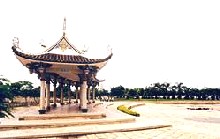
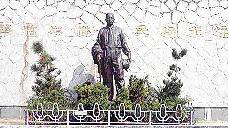
 Gulangyu Island is located just southwest of Xiamen City. The most attractive
place should be the Gulangyu Island, which prohibits motor vehicles.
With rich tourist resources of intriguing scenery, historical
relics and architectures of varied styles, the Gulangyu is promising
to be a national tourist attraction and surely is a must-see
during your trip to Xiamen.
Gulangyu Island is located just southwest of Xiamen City. The most attractive
place should be the Gulangyu Island, which prohibits motor vehicles.
With rich tourist resources of intriguing scenery, historical
relics and architectures of varied styles, the Gulangyu is promising
to be a national tourist attraction and surely is a must-see
during your trip to Xiamen. The Sunlight Rock, which claims to be Xiamen's highest point and
the Shuzhuang Garden are highly recommended. Haoyue (Bright
Moon) Park and the Piano Museum are also appealing to visitors.
The boat to the island runs from early morning to midnight from
the pier across from the Lujiang, the short ride offering delightful
views of the waterways. The island center-knot of small shopping
streets with a Bank of China, a post office, a few restaurants
and shops- is ahead as you disembark from the ferry.
The Sunlight Rock, which claims to be Xiamen's highest point and
the Shuzhuang Garden are highly recommended. Haoyue (Bright
Moon) Park and the Piano Museum are also appealing to visitors.
The boat to the island runs from early morning to midnight from
the pier across from the Lujiang, the short ride offering delightful
views of the waterways. The island center-knot of small shopping
streets with a Bank of China, a post office, a few restaurants
and shops- is ahead as you disembark from the ferry.  Shortly
beyond the garden, the road heads west towards the middle of
the island, bringing you to a sports ground, with the old colonial
Gulangyu Guesthouse facing onto it. President Nixon stayed here
on his 1972 trip. The middle building has its original 1920s
d¨¦cor and furniture intact, with dark wooden paneling, a billiard
hall and a terrace with rattan chairs.
Shortly
beyond the garden, the road heads west towards the middle of
the island, bringing you to a sports ground, with the old colonial
Gulangyu Guesthouse facing onto it. President Nixon stayed here
on his 1972 trip. The middle building has its original 1920s
d¨¦cor and furniture intact, with dark wooden paneling, a billiard
hall and a terrace with rattan chairs.  d training grounds of
Zheng Chenggong's troops. Near the field is a huge rock bridging
two cliffs, forming a natural entrance to a cave. This is called
'Old Summer Cave' (Gu Bishu Dong). It is the perfect viewing
spot to appreciate the scenery of Gulangyu Island. A fantastic
panorama of Xiamen City, including Nanputuo Temple, Xiamen University,
and Hulishan Battery is within view.
d training grounds of
Zheng Chenggong's troops. Near the field is a huge rock bridging
two cliffs, forming a natural entrance to a cave. This is called
'Old Summer Cave' (Gu Bishu Dong). It is the perfect viewing
spot to appreciate the scenery of Gulangyu Island. A fantastic
panorama of Xiamen City, including Nanputuo Temple, Xiamen University,
and Hulishan Battery is within view.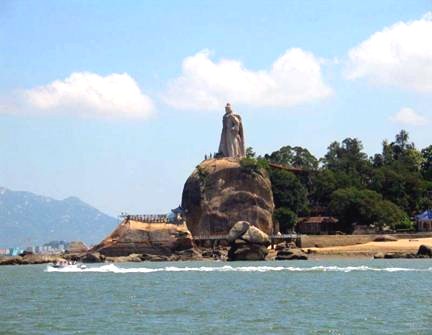
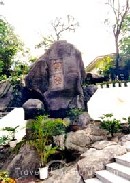 First
built in 1931 on the south side of the island, Shuzhuang Garden
was once a private villa. It became a garden park open to the
public in 1955. It is divided into two parts-the Garden of Hiding
the Sea (Canghaiyuan) and the Garden of Making-Up Hills (Bushanyuan).
It was exquisitely designed to embody three important characteristics
in gardening - hiding elements, borrowing from one's surroundings,
and combining movements. The garden is full of flowers and boasting
some nicely shaded areas for taking tea right by the sea.
First
built in 1931 on the south side of the island, Shuzhuang Garden
was once a private villa. It became a garden park open to the
public in 1955. It is divided into two parts-the Garden of Hiding
the Sea (Canghaiyuan) and the Garden of Making-Up Hills (Bushanyuan).
It was exquisitely designed to embody three important characteristics
in gardening - hiding elements, borrowing from one's surroundings,
and combining movements. The garden is full of flowers and boasting
some nicely shaded areas for taking tea right by the sea.  The
museum is a reflection of the island's history with the instrument;
foreigners began to teach locals here at the start of the twentieth
century and the island has produced some of China's finest pianists-if
you stay, chances are you'll hear the tinkling of ivories drifting
across the hills. The museum contains over a hundred pianos
from Austria, France, Germany and Britain, including the odd
Stainway and apparently the world's tallest upright piano.
The
museum is a reflection of the island's history with the instrument;
foreigners began to teach locals here at the start of the twentieth
century and the island has produced some of China's finest pianists-if
you stay, chances are you'll hear the tinkling of ivories drifting
across the hills. The museum contains over a hundred pianos
from Austria, France, Germany and Britain, including the odd
Stainway and apparently the world's tallest upright piano.
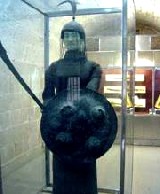 Hulishan
Battery Scenic Spot is one of the most exciting attractions of
Xiamen. It lies to the south of the Xiamen Island. It's in
this fortress where the Krupp cannons stand. These German-made
cannons stand high and mighty and preserved. Get ready for some
history now. Ready, aim, fire the cannons!
Hulishan
Battery Scenic Spot is one of the most exciting attractions of
Xiamen. It lies to the south of the Xiamen Island. It's in
this fortress where the Krupp cannons stand. These German-made
cannons stand high and mighty and preserved. Get ready for some
history now. Ready, aim, fire the cannons!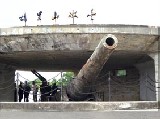 These
cannons, produced in 1886, were bought from a German arsenal
at a cost of 80,000 taels of silver each. The remaining cannon
is more than 13 meters (about 42.7 feet) long and weighs 50 tons.
It has a range of 1,600 meters (about one mile). It is the largest
and oldest 19th century breechloader in existence. Additionally,
there are more than 50 iron cannons made during in the Ming (1368
- 1644) and the Qing Dynasties on the grounds. Between the eastern
and the southern batteries is a tunnel in which 29 cannonballs
are now on display. At the exit of the tunnel are the barracks.
Hulishan Battery was an important defensive factor during the
war against Japanese aggression in 1900 and 1937.
These
cannons, produced in 1886, were bought from a German arsenal
at a cost of 80,000 taels of silver each. The remaining cannon
is more than 13 meters (about 42.7 feet) long and weighs 50 tons.
It has a range of 1,600 meters (about one mile). It is the largest
and oldest 19th century breechloader in existence. Additionally,
there are more than 50 iron cannons made during in the Ming (1368
- 1644) and the Qing Dynasties on the grounds. Between the eastern
and the southern batteries is a tunnel in which 29 cannonballs
are now on display. At the exit of the tunnel are the barracks.
Hulishan Battery was an important defensive factor during the
war against Japanese aggression in 1900 and 1937.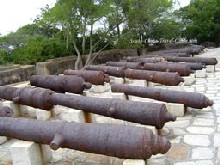
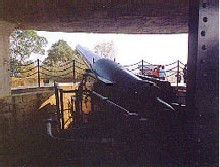
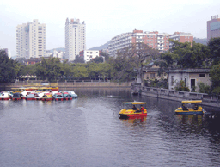

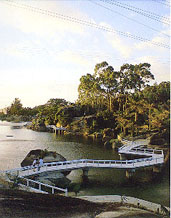 Ten-Thousand
rock in Lion Mountain in the east suburb of Xiamen is well-known
for its countless grotesque rocks, some lying on cliffs, some
standing on slopes, some looking like jade screens, some resembling
an old man. Viewed from different angles, they present different
features, like a man or an animal, but all vivid and alive.
Ten-Thousand
rock in Lion Mountain in the east suburb of Xiamen is well-known
for its countless grotesque rocks, some lying on cliffs, some
standing on slopes, some looking like jade screens, some resembling
an old man. Viewed from different angles, they present different
features, like a man or an animal, but all vivid and alive. 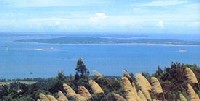 Jinmen
Island lies alone outside Xiamen in the east, with the shortest
distance of only 2310 meters from Xiamen, being a place of strategic
importance in South Fujian. It is a country under Xiamen, but
under the control of Taiwan government, with an area of 148 square
kilometers and about 50,000 population. A boat trip around Jinmen
from various places including the waterfront opposite Zhongshan
Lu is very impressive.
Jinmen
Island lies alone outside Xiamen in the east, with the shortest
distance of only 2310 meters from Xiamen, being a place of strategic
importance in South Fujian. It is a country under Xiamen, but
under the control of Taiwan government, with an area of 148 square
kilometers and about 50,000 population. A boat trip around Jinmen
from various places including the waterfront opposite Zhongshan
Lu is very impressive.  Jinmen
has a long history of civilization. It was called "Fairy
Island" and "Beautiful Haven of Peace". In the 1,600 years'
civilization, a great number of historic relics have been left.
It was said that people began to live here as early as the Eastern
and Western Dynasty. Before the Jin Dynasty about eight centuries
ago it was still a part of the mainland. In 803, the 19th year
of Yuanzhen in the Tang Dynasty, a government official Chen Yuan
led 12 families to reclaim the land. After 935, the first year
of Yonglong, it belonged to Tongan country of Fujian Province,
and since the Song Dynasty there have been civil governments
and military headquarters. Since the Ming Dynasty, it has been
called Jinmen, meaning a "strong gate as if made of gold",
for the place was like a gate controlling the sea area. In 1914,
Jinmen became affiliated to Xiamen and since 1915 it has been
a country.
Jinmen
has a long history of civilization. It was called "Fairy
Island" and "Beautiful Haven of Peace". In the 1,600 years'
civilization, a great number of historic relics have been left.
It was said that people began to live here as early as the Eastern
and Western Dynasty. Before the Jin Dynasty about eight centuries
ago it was still a part of the mainland. In 803, the 19th year
of Yuanzhen in the Tang Dynasty, a government official Chen Yuan
led 12 families to reclaim the land. After 935, the first year
of Yonglong, it belonged to Tongan country of Fujian Province,
and since the Song Dynasty there have been civil governments
and military headquarters. Since the Ming Dynasty, it has been
called Jinmen, meaning a "strong gate as if made of gold",
for the place was like a gate controlling the sea area. In 1914,
Jinmen became affiliated to Xiamen and since 1915 it has been
a country.